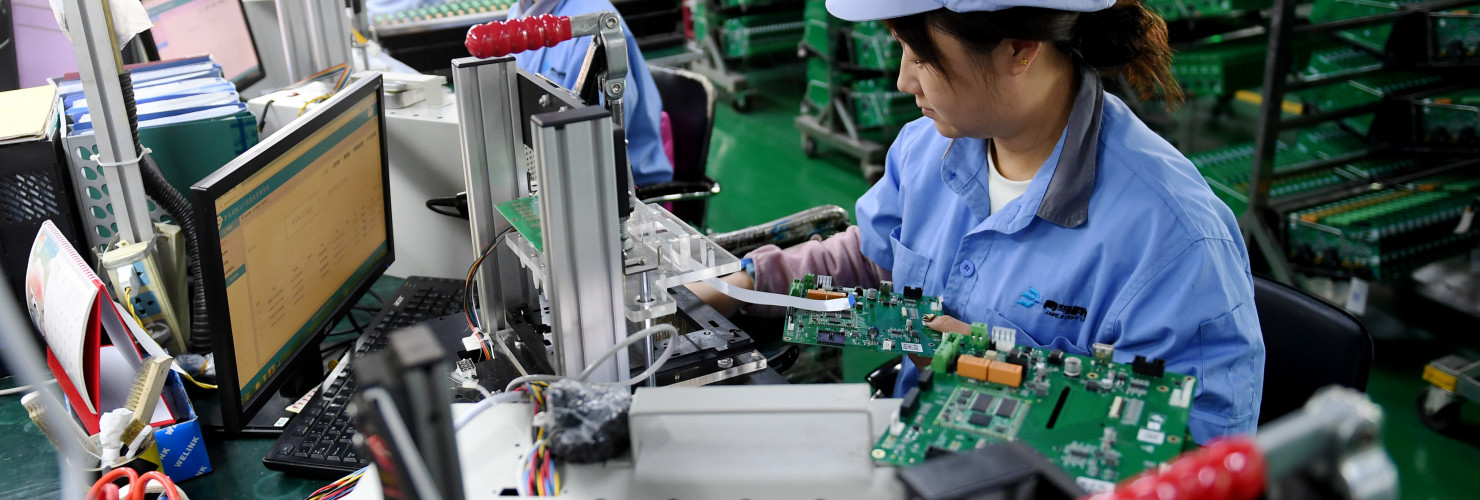

Industrial system of testing equipment + Little Giants in niche markets + strategy for digital development
MERICS TOP 5
1. China intends to build a complete industrial system of intelligent testing equipment
At a glance: The Ministry of Industry and Information Technology (MIIT) and six other government ministries and bodies issued a three-year action plan to spur the development of China’s intelligent testing equipment industry, referring to specialized machinery used to test the quality and performance of products. The plan aims to strengthen China’s position in the sector by promoting downstream applications and cultivating upstream suppliers. Goals for 2025 include:
- Establish a comprehensive industrial system of intelligent testing equipment (covering everything from materials to software, from talent to standards)
- Achieve breakthroughs in at least 50 types of intelligent testing equipment, core components and specific software (such as high-precision industrial cameras or encoders)
- Cultivate at least 30 Little Giant companies (China’s version of high-tech SMEs) focused on the intelligent testing industry
- Promote at least 100 intelligent testing demonstration applications in sectors like automotive, machinery or aerospace
MERICS comment: Intelligent testing equipment is key for China’s longstanding aim to integrate digital technologies in traditional manufacturing to boost productivity and promote industrial upgrading. The use of advanced intelligent testing equipment also becomes necessary as China aims to manufacture high-tech goods like commercial aircraft that have very high safety standards.
However, in the eyes of Beijing’s policymakers the dominance of foreign firms in the high-end segment of testing equipment could thwart upgrading plans: 90 percent of China’s high-end testing equipment is imported, some of which is subject to export controls. In 2021 the United States’ government fined Keysight Technologies, a leading American instrument maker, for exporting software to China that is used to test radar equipment. As part of a technology self-reliance push, Beijing now emphasizes the need to build a complete Chinese industrial system.
For European suppliers, many of which currently dominate the sector, this policy could have negative consequences. Chinese competitors will benefit from additional policy support, also in the form of China’s Little Giant program (see next entry). Beijing’s ambition is for Chinese firms to first gain market shares within China, primarily to boost economic security, and then expand globally to reap economic benefits.
Article: Action Plan for the Development of the Intelligent Testing Equipment Industry (2023-2025) (智能检测装备产业发展行动计划(2023—2025年)) (Link)
Issuing body: MIIT, NDRC, MOE, MOF, SAMR, CAE, SASTIND
Date: February 23, 2023
2. Little Giants are drawn to niche markets
At a glance: The Ministry of Industry and Information Technology launched the selection of the fifth batch of Little Giant enterprises and a review of the second batch (due to a limited 3-year validity of the Little Giant status). Provincial MIIT officials will conduct the preliminary review of candidates and submit their suggestions to the national MIIT department. The detailed selection criteria are tailored to identify firms that:
- Address weaknesses and fill gaps in the domestic supply chain, and serve to substitute imports
- Lead in niche markets (such as intelligent testing equipment or machinery components), either domestically or internationally (applicants ought to hold at least 10 percent of national market share in their main product areas), and have strong export performance record
- Demonstrate strong innovation capacity, either through a high ratio of R&D expenses to revenue and existing intellectual property, or through China’s national science and technology awards or SME innovation competition
- Show strong economic performance, with an average growth rate in main business income over five percent during the past two years
MERICS comment: The Little Giants program was launched in 2018 to cultivate high-tech SMEs and advance the government’s innovation and self-reliance goals. To date 8,997 firms have been granted Little Giant status across four batches. With the fifth batch Beijing will likely meet its target of cultivating a total of 10,000 Little Giant firms before the 2025 deadline.
Changes to selection criteria for the Little Giants program reflect Beijing’s increased focus on self-reliance. While criteria related to economic performance and specialization have remained basically consistent over consecutive batches, the criteria for the fourth and fifth batches of Little Giants have added a new emphasis on the ability of applicants to overcome technological bottlenecks and substitute imports.
This means more state support (e.g., improved access to finance or R&D funding) will flow to innovative SMEs in priority sectors, which will add pressure on foreign firms as China aims to replace them. This process has already begun. Little Giant Ningbo Peiyuan, an automotive supplier specializing in shock absorber piston rods, now occupies nearly 40 percent of domestic market share and exports to dozens of countries. It is possible that such firms would succeed without government support, but the Little Giants program will further accelerate the ability for China’s SMEs to challenge foreign companies.
Article: Notice on the Cultivation of the Fifth Batch of Specialized "Little Giant" Enterprises and Review of the Second Batch of "Little Giant" Enterprises (工业和信息化部办公厅关于开展第五批专精特新“小巨人”企业培育和第二批专精特新“小巨人”企业复核工作的通知) (Link)
Issuing body: MIIT
Date: February 20, 2022
3. A new “grand strategy” will shape China’s digital development
At a glance: The Central Committee of the CCP and the State Council published the “Plan for the Overall Layout of Building a Digital China.” The high-level grand strategy lays out objectives for the coming years to achieve Xi Jinping’s vision of a Digital China. Specific implementation plans can be expected to follow. The four main targets for 2025 include:
- Complete building the country’s digital infrastructure, which includes further developing 5G and gigabit optical networks, as well as Beidou (China‘s satellite system) applications but also improving its data use and management
- Expand the use of digital technologies into all aspects of life, including politics, society, ecology, economics, and culture
- Strengthen China’s self-reliance in core technologies (such as AI, 5G or space tech) by reducing dependencies on foreign technology providers
- Develop domestic technical standards and strengthen international digital cooperation, especially with countries along the Digital Silk Road
MERICS comment: The Plan is meant to explain how the “great rejuvenation of the Chinese nation through Chinese-style modernization” can be realized by providing an overall structure not just for the digital economy, but everything digital. The strategy ties together existing objectives and sends an important signal to private sector and state stakeholders to prioritize the implementation of ‘Digital China’. The concept was introduced in 2016 by Xi as the digital component to China’s unique development model to promote material prosperity without liberal democratic values.
An important difference to previous grand strategies is the emphasis on party ideology. The Plan’s four core elements are codified into the “2522-Formula,” whereby each number corresponds to a policy slogan that CCP cadres should be familiar with. Another key change is the focus on strategic international cooperation, which previously was not part of ‘Digital China’.
After a two-year rectification campaign against China’s digital sector, the strategy also outlines the new business environment for private sector actors. The ICT sector will continue to see huge business opportunities for manufacturers, while platforms will face more pressure operating within a system that expects patriotic and paternalistic content. Foreign companies have not had an easy business environment in China thus far and now face new complexities.
Article: Plan for the Overall Layout of Building a Digital China (数字中国建设整体布局规划) (Link)
Issuing body: Central Committee and the State Council
Date: February 27, 2023
4. Government provides tax breaks to semiconductor and software companies who spend on R&D
At a glance: Five government bodies including the National Development and Reform Commission (NDRC) and MIIT issued annual guidance for provincial DRCs and other responsible bodies on how to compile lists of preferential tax policies for integrated circuit (IC) and software firms. This guidance follows a 2020 notice to promote the IC and software industry. Companies on the list can be in the following categories:
- Chip manufacturers or designers, as well as companies with major projects in these areas
- Suppliers to chip manufacturers
- Software companies, e.g., for industrial software, information security and public management software
- Advanced packaging and testing IC enterprises
MERICS comment: China’s government has long been pushing for the development of the IC and software industries to promote economic development and technological self-reliance. To increase the efficiency of state support, the central government is issuing these detailed instructions to the provincial level for implementation.
Greater centralization in key sectors is meant to allow the central government to promote priority areas by making requirements for certain sub-sectors either more or less stringent. In addition, the government requires and incentivizes companies to increase R&D intensity by laying out specific criteria like the proportion of employees with at least a bachelor’s degree and the percentage of revenue spent on R&D.
The implementation guidelines do not focus specifically on the key technologies China still wants, and instead, suggest very broad categories. For example, there is no difference in how IC manufacturers at different nodes are treated, although the guidance seems set up to include such differentiation more broadly. This suggests that currently, China’s central government is focusing on quantity over quality. While this is a necessary first step for building up a successful IC industry in China, at a point, the government will need to shift to a quality-first approach and cull the industry to support only the best firms.
Article: Notice on Relevant Requirements for Making a List of Integrated Circuit Enterprises or Projects and Software Enterprises Enjoying Preferential Tax Policies (关于做好2023年享受税收优惠政策的集成电路企业或项目、软件企业清单制定工作有关要求的通知) (Link)
Issuing body: NDRC, MIIT, MOF, Customs Administration, STA
Date: March 17, 2023
5. China promotes digitalized rail connections to ports to boost logistic systems
At a glance: Five government agencies led by the Ministry of Transportation released a three-year action plan to promote the high-quality development of rail-water intermodal transport. This means increasing the interlinkage between railway lines and ports to smooth transportation of freight. Key targets for 2025 include:
- Fully connect the main ports of the Yangtze River to railway lines, so that 90 percent of goods transported to and from ports will come by rail
- Reach a 14 million TEU (twenty-foot equivalent unit) volume of container rail-port transportation, with an average annual growth of more than 15 percent
- Increase the development and application of digital technologies, such as 5G applications, big data and artificial intelligence, in the railway and transportation industry
MERICS comment: The action plan is part of a broader push to further improve China’s logistics system which underpins the country’s manufacturing strength. In recent months, several policies were released with the aim to better integrate China’s freight and logistics hubs. Provinces such as Hunan are leveraging the policy push to advance feasibility studies on intermodal transport links, including railway lines connected to ports. The focus on digital technologies is not exclusive to logistics, but part of a broader push to integrate emerging technologies into the real economy.
The strong support for intermodal transport could further enhance China’s position as a global manufacturing center. For firms in China, including foreign ones, this policy push could be highly beneficial by promoting faster, greener and safer transportation of goods. The construction of rail lines will primarily fall into the hands of Chinese SOEs, but the operation and digitalization of these intermodal transport links offers at least niche opportunities for foreign firms.
Article: Action Plan for Promoting the High-quality Development of Iron-Water Intermodal Transport (2023-2025) (推进铁水联运高质量发展行动方案(2023—2025年》的通) (Link)
Issuing bodies: MOT, DONR, NRA, CNRGC
Date: March, 14, 2023
NOTEWORTHY
Policy News
- March 9: The MIIT is asking local SME departments to highlight industrial clusters in a bid to promote manufacturing based SMEs (MIIT notice)
- March 14: MOST says that the first international standard on nuclear fusion (ISO4233:2023) is based on Chinese research, touting China’s success in international standard setting (MOST notice)
- March 15: The MIIT has announced a list of industrial internet pilot demonstration projects in 2022 – covering 218 projects in 20 areas such as fully-5G-connected-factory pilots (MIIT announcement)
- March 16: The NDRC is soliciting opinions on the “Green Industry Guidance Catalogue” which aims to promote green industries including recycling and clean energy generation (NDRC Announcement)
Corporate News
- February 22: State-owned carmaker GAC Group will set up a USD 4.35 billion investment fund for investments in automotive chips, smart and connected vehicles, and energy ecology that will cooperate with the Guangzhou government (Yicai Global article)
- February 23: German chemical company Covestro announced plans to build its largest thermoplastic polyurethanes (TPU) site in China with a total expected investment in the low three-digit million euro range (Covestro press release)
- February 23: Apple has chosen China’s Luxshare to work on augmented reality devices, the first time Apple has used a Chinese supplier for a first-generation product (Asia Nikkei article)
- March 2: Saudi Aramco signed a letter of intent to become a minority stakeholder in a JV between Geely and Renault to develop next-generation powertrain technologies (Aramco press release)
- March 7: China’s auto sector faces a price war in both electric and internal combustion engine vehicle segments amid lower than expected sales that has led local governments to offer subsidies for new cars (Yicai Global article)
- March 20: Chinese electronics maker Universal Scientific Industrial (USI) is acquiring Swiss automotive electronics business TE Connectivity (Yicai Global article)



